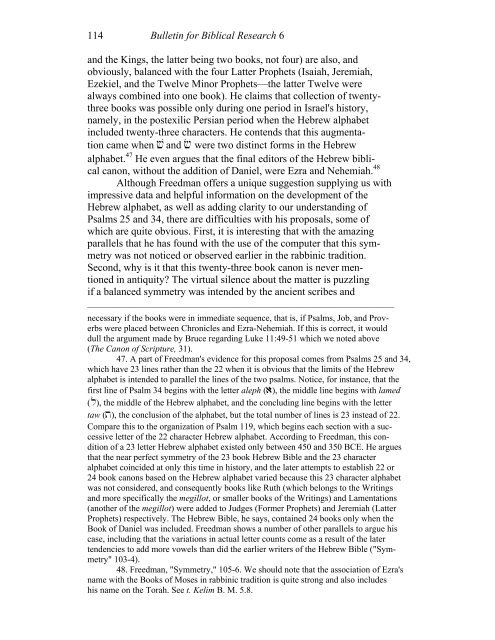The Integrity of the Biblical Canon in Light of Its Historical ...
The Integrity of the Biblical Canon in Light of Its Historical ...
The Integrity of the Biblical Canon in Light of Its Historical ...
Create successful ePaper yourself
Turn your PDF publications into a flip-book with our unique Google optimized e-Paper software.
114 Bullet<strong>in</strong> for <strong>Biblical</strong> Research 6<br />
and <strong>the</strong> K<strong>in</strong>gs, <strong>the</strong> latter be<strong>in</strong>g two books, not four) are also, and<br />
obviously, balanced with <strong>the</strong> four Latter Prophets (Isaiah, Jeremiah,<br />
Ezekiel, and <strong>the</strong> Twelve M<strong>in</strong>or Prophets—<strong>the</strong> latter Twelve were<br />
always comb<strong>in</strong>ed <strong>in</strong>to one book). He claims that collection <strong>of</strong> twentythree<br />
books was possible only dur<strong>in</strong>g one period <strong>in</strong> Israel's history,<br />
namely, <strong>in</strong> <strong>the</strong> postexilic Persian period when <strong>the</strong> Hebrew alphabet<br />
<strong>in</strong>cluded twenty-three characters. He contends that this augmentation<br />
came when #$ and #& were two dist<strong>in</strong>ct forms <strong>in</strong> <strong>the</strong> Hebrew<br />
alphabet. 47 He even argues that <strong>the</strong> f<strong>in</strong>al editors <strong>of</strong> <strong>the</strong> Hebrew biblical<br />
canon, without <strong>the</strong> addition <strong>of</strong> Daniel, were Ezra and Nehemiah. 48<br />
Although Freedman <strong>of</strong>fers a unique suggestion supply<strong>in</strong>g us with<br />
impressive data and helpful <strong>in</strong>formation on <strong>the</strong> development <strong>of</strong> <strong>the</strong><br />
Hebrew alphabet, as well as add<strong>in</strong>g clarity to our understand<strong>in</strong>g <strong>of</strong><br />
Psalms 25 and 34, <strong>the</strong>re are difficulties with his proposals, some <strong>of</strong><br />
which are quite obvious. First, it is <strong>in</strong>terest<strong>in</strong>g that with <strong>the</strong> amaz<strong>in</strong>g<br />
parallels that he has found with <strong>the</strong> use <strong>of</strong> <strong>the</strong> computer that this symmetry<br />
was not noticed or observed earlier <strong>in</strong> <strong>the</strong> rabb<strong>in</strong>ic tradition.<br />
Second, why is it that this twenty-three book canon is never mentioned<br />
<strong>in</strong> antiquity? <strong>The</strong> virtual silence about <strong>the</strong> matter is puzzl<strong>in</strong>g<br />
if a balanced symmetry was <strong>in</strong>tended by <strong>the</strong> ancient scribes and<br />
_____________________________________________________________________<br />
necessary if <strong>the</strong> books were <strong>in</strong> immediate sequence, that is, if Psalms, Job, and Proverbs<br />
were placed between Chronicles and Ezra-Nehemiah. If this is correct, it would<br />
dull <strong>the</strong> argument made by Bruce regard<strong>in</strong>g Luke 11:49-51 which we noted above<br />
(<strong>The</strong> <strong>Canon</strong> <strong>of</strong> Scripture, 31).<br />
47. A part <strong>of</strong> Freedman's evidence for this proposal comes from Psalms 25 and 34,<br />
which have 23 l<strong>in</strong>es ra<strong>the</strong>r than <strong>the</strong> 22 when it is obvious that <strong>the</strong> limits <strong>of</strong> <strong>the</strong> Hebrew<br />
alphabet is <strong>in</strong>tended to parallel <strong>the</strong> l<strong>in</strong>es <strong>of</strong> <strong>the</strong> two psalms. Notice, for <strong>in</strong>stance, that <strong>the</strong><br />
first l<strong>in</strong>e <strong>of</strong> Psalm 34 beg<strong>in</strong>s with <strong>the</strong> letter aleph ()), <strong>the</strong> middle l<strong>in</strong>e beg<strong>in</strong>s with lamed<br />
(l), <strong>the</strong> middle <strong>of</strong> <strong>the</strong> Hebrew alphabet, and <strong>the</strong> conclud<strong>in</strong>g l<strong>in</strong>e beg<strong>in</strong>s with <strong>the</strong> letter<br />
taw (t), <strong>the</strong> conclusion <strong>of</strong> <strong>the</strong> alphabet, but <strong>the</strong> total number <strong>of</strong> l<strong>in</strong>es is 23 <strong>in</strong>stead <strong>of</strong> 22.<br />
Compare this to <strong>the</strong> organization <strong>of</strong> Psalm 119, which beg<strong>in</strong>s each section with a successive<br />
letter <strong>of</strong> <strong>the</strong> 22 character Hebrew alphabet. Accord<strong>in</strong>g to Freedman, this condition<br />
<strong>of</strong> a 23 letter Hebrew alphabet existed only between 450 and 350 BCE. He argues<br />
that <strong>the</strong> near perfect symmetry <strong>of</strong> <strong>the</strong> 23 book Hebrew Bible and <strong>the</strong> 23 character<br />
alphabet co<strong>in</strong>cided at only this time <strong>in</strong> history, and <strong>the</strong> later attempts to establish 22 or<br />
24 book canons based on <strong>the</strong> Hebrew alphabet varied because this 23 character alphabet<br />
was not considered, and consequently books like Ruth (which belongs to <strong>the</strong> Writ<strong>in</strong>gs<br />
and more specifically <strong>the</strong> megillot, or smaller books <strong>of</strong> <strong>the</strong> Writ<strong>in</strong>gs) and Lamentations<br />
(ano<strong>the</strong>r <strong>of</strong> <strong>the</strong> megillot) were added to Judges (Former Prophets) and Jeremiah (Latter<br />
Prophets) respectively. <strong>The</strong> Hebrew Bible, he says, conta<strong>in</strong>ed 24 books only when <strong>the</strong><br />
Book <strong>of</strong> Daniel was <strong>in</strong>cluded. Freedman shows a number <strong>of</strong> o<strong>the</strong>r parallels to argue his<br />
case, <strong>in</strong>clud<strong>in</strong>g that <strong>the</strong> variations <strong>in</strong> actual letter counts come as a result <strong>of</strong> <strong>the</strong> later<br />
tendencies to add more vowels than did <strong>the</strong> earlier writers <strong>of</strong> <strong>the</strong> Hebrew Bible ("Symmetry"<br />
103-4).<br />
48. Freedman, "Symmetry," 105-6. We should note that <strong>the</strong> association <strong>of</strong> Ezra's<br />
name with <strong>the</strong> Books <strong>of</strong> Moses <strong>in</strong> rabb<strong>in</strong>ic tradition is quite strong and also <strong>in</strong>cludes<br />
his name on <strong>the</strong> Torah. See t. Kelim B. M. 5.8.
















